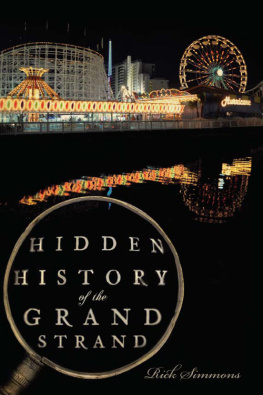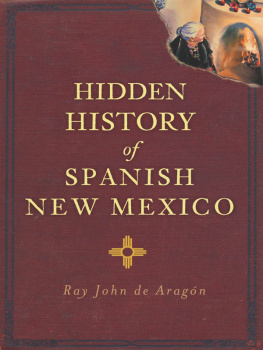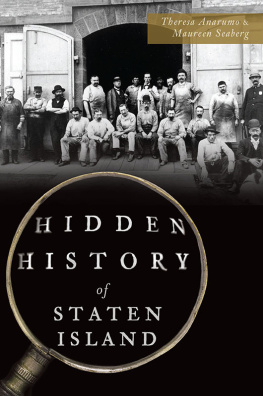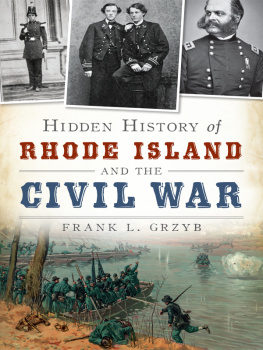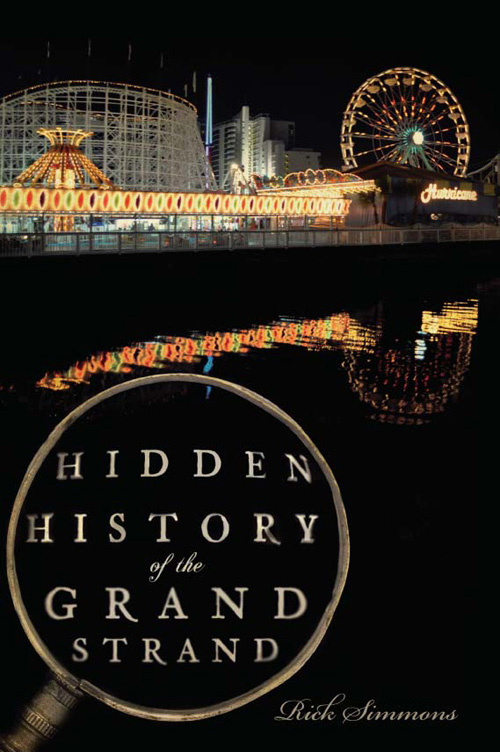HIDDEN
HISTORY
of the
GRAND
STRAND
HIDDEN
HISTORY
of the
GRAND
STRAND
Rick Simmons

Published by The History Press
Charleston, SC 29403
www.historypress.net
Copyright 2010 by Rick Simmons
All rights reserved
Cover image by Mike Burton
First published 2010
e-book edition 2011
ISBN 978.1.61423.211.7
Simmons, Rick.
Hidden history of the Grand Strand / Rick Simmons.
p. cm.
Includes bibliographical references.
print edition ISBN 978-1-59629-966-5
1. Myrtle Beach Region (S.C.)--History. 2. Myrtle Beach Region (S.C.)--History, Local.
3. Historic buildings--South Carolina--Myrtle Beach Region. 4. Historic sites--South
Carolina--Myrtle Beach Region. 5. Georgetown County (S.C.)--History, Local. I. Title.
F279.M93S56 2010
975.789--dc22
2010017386
Notice: The information in this book is true and complete to the best of our knowledge. It is offered without guarantee on the part of the author or The History Press. The author and The History Press disclaim all liability in connection with the use of this book.
All rights reserved. No part of this book may be reproduced or transmitted in any form whatsoever without prior written permission from the publisher except in the case of brief quotations embodied in critical articles and reviews.
C ONTENTS
Chapter 7. The Hot and Hot Fish Club, and the
Hidden History of Drunken Jack Island
Chapter 10. Four Grand Strand Landmarks that Disappeared
Before their Time
P REFACE
I must admit that Im surprised and delighted to find that, just one year after writing a very similar acknowledgements page for my book Defending South Carolinas Coast: The Civil War from Georgetown to Little River, Im once again doing the same thing for yet another book from The History Press. Like my first book, this was not a volume that just appeared overnight, despite what one might think because of the short time between the two publications. Just as my last book originated in the early 1990s with a series of historical articles in South Carolinabased magazines, this book also drew on a few pieces I had written nearly twenty years ago. The chapters herein dealing with Old Gunn Church, the U-boat enigma and the Hot and Hot Fish Club are, at least in part, based on articles I published some time ago, although the extensive research I did on North Island, the Ocean Forest and the disappearing landmarks is all new (and concerning topics I never got to write about the first time around). Its likely that I would have written about these things at some point had I remained living at the beach, but when we left the coast so that I could pursue a PhD, my nonacademic writing career went on a twenty-year hiatus. I earned my masters degree and PhD and moved to Louisiana, where I became, and am currently, a professor at Louisiana Tech University.
As my wife and I raised our children, and as I spent my time publishing the things required for tenure and promotion, there was little time to return to those topics I had researched and thought about in the early 1990s. We would vacation at our family home on Pawleys Island every summer, sometimes spending as much as a month there, and during those trips I would occasionally think about and visit the places of interest covered in this book. However, living one thousand miles away and with little time for writing as a hobby, thinking about it is about as far as it went.
Once I had tenure, and then after being promoted to full professor, I felt that it was time to revisit the topics I had addressed so many years before. My first order of business was to finish my book about the Civil War, Defending South Carolinas Coast, and after being fortunate enough to place it with the exceptional History Press, I decided to put together a book based on some other topics I had investigated so long ago. Within a year, I was ready with what was to become this book, and Laura All, the great commissioning editor at The History Press, informed me that they would like to pick up the option on this book as well.
So here I sit, elated that Hidden History of the Grand Strand will complete the cycle of those individually themed topics about which I also wanted to write a book but never had time to address. I expect Ill have to move in another direction next time.
A few people deserve mention here for a variety of reasons. Once again, Scott Lawrence unselfishly and on a number of occasions took my family out boating in Winyah Bay and Murrells Inlet to visit the islands. I also thank him for running out to snap a few updated pictures of the Harvest Moon and Battery White, for letting me use them in this book and for taking us out in his boat to Drunken Jack Island in the cold of winter of December 2009 so that I could examine what might have been, and what I think proved to be, the remains of Fort Ward. Of course my wife Sue, daughter Courtenay and son Cord have always been supportive, but the problem is that with each book I publish about the area, my wife becomes further convinced that its another sign that we need to move back home! My father and sister have always been supportive, and so I owe them thanks as well. Between Julie and Dad, Im able to take my family back to South Carolina, stay weeks at a time and visit and research these places I like to write about.
Robin Salmon, vice-president for collections and curator of sculpture at Brookgreen Gardens, helped me with information yet again, and I thank her for all she has done for both books now. Id like to thank Jack Shaum of the Steamship Historical Society of America, who may be worlds greatest expert on the City of Richmond and was gracious enough to lend me his one-of-a-kind pictures of that ship. Jamie Dozier, project leader at the Tom Yawkey Wildlife Center, was also very helpful, and I appreciate his information about North Island. Jill Santopietro, director of the Georgetown County Museum, gave me information as well. Jennifer Ledet helped me with some picture problems I had. I appreciate the Pawleys Island Civic Association for letting me use the fantastic photographs in its collection. Julie Warren, with the Georgetown County Digital Library, went above and beyond the call of duty, getting permission for me to use photographs again and again, and Im not sure anyone could have helped me more, or have been more gracious, than Julie. Id also like to thank my old friend, college roommate and fraternity brother, Steve Bond. Sometimes you just need someone outside your family to really believe in what youre doing, and I couldnt have had a more ardent supporter than I had in him on this and my previous bookthanks Bondo (and Margaret, too). Finally, I thank those of you who will buy this book. Publishers print them because of you, and you have my sincerest thanks.
Chapter 1
H ISTORIC N ORTH I SLAND
North Island is arguably the most colorful and historically important area along the Grand Strand. It may well have been the site of the first recorded shipwreck in North America, it probably would have been the site of the first Spanish settlement in America, it was one of the first vacation resorts in America and it still is the location of the oldest existing lighthouse in South Carolina (and one of the oldest lighthouses in the United States). Based on its historical importance, one could easily write an entire book about North Island, yet today the island sits completely uninhabited, home to a few crumbling and unoccupied buildings and a now-automated lighthouse. How did this important island go from being home to a villagereplete with a church, a school, a proposed base for British troops, Confederate and Union forts and a flourishing resortto an abandoned island today? The answers are as intriguing as the questions.

